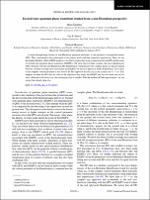Please use this identifier to cite or link to this item:
https://hdl.handle.net/20.500.12202/4296Full metadata record
| DC Field | Value | Language |
|---|---|---|
| dc.contributor.author | Sindelka, Milan | - |
| dc.contributor.author | Santos, Lea F. | - |
| dc.contributor.author | Moiseyev, Nimrod | - |
| dc.date.accessioned | 2018-12-31T21:03:53Z | - |
| dc.date.available | 2018-12-31T21:03:53Z | - |
| dc.date.issued | 2017-01-24 | - |
| dc.identifier.citation | Sindelka, M., Santos, L.F., and Moiseyev, N. (2017). Excited-state quantum phase transitions studied from a non-Hermitian perspective. Physical Review A 95: 010103(R). | en_US |
| dc.identifier.issn | 2469-992 | - |
| dc.identifier.uri | https://doi.org/10.1103/PhysRevA.95.010103 | en_US |
| dc.identifier.uri | https://hdl.handle.net/20.500.12202/4296 | - |
| dc.description.abstract | A main distinguishing feature of non-Hermitian quantum mechanics is the presence of exceptional points (EPs). They correspond to the coalescence of two energy levels and their respective eigenvectors. Here, we use the Lipkin-Meshkov-Glick (LMG) model as a test bed to explore the strong connection between EPs and the onset of excited state quantum phase transitions (ESQPTs). We show that for finite systems, the exact degeneracies (EPs) obtained with the non-Hermitian LMG Hamiltonian continued into the complex plane are directly linked with the avoided crossings that characterize the ESQPTs for the real (physical) LMG Hamiltonian. The values of the complex control parameter α that lead to the EPs approach the real axis as the system size N→∞. This happens for both the EPs that are close to the separatrix that marks the ESQPT and also for those that are far away, although in the latter case, the convergence rate is smaller. With the method of Padé approximants, we can extract the critical value of α. | en_US |
| dc.description.sponsorship | M.S. was supported by the Czech Ministry of Education Grant No. LG15013, L.F.S. by the American National Science Foundation (NSF) Grants No. DMR-1147430 and No. DMR-1603418, and N.M. by the I-Core: the Israeli Excellence Center Circle of Light, by the Israel Science Foundation Grants No. 298/11 and No. 1530/15. We thank Ofir Alon, Francisco P´erez-Bernal, and Saar Rahav for fruitful discussions. | en_US |
| dc.language.iso | en_US | en_US |
| dc.publisher | American Physical Society | en_US |
| dc.relation.ispartofseries | Physical Review A;95 | - |
| dc.rights | Attribution-NonCommercial-NoDerivs 3.0 United States | * |
| dc.rights.uri | http://creativecommons.org/licenses/by-nc-nd/3.0/us/ | * |
| dc.subject | quantum phase transitions | en_US |
| dc.subject | exceptional points (EPs) | en_US |
| dc.subject | Lipkin-Meshkov-Glick (LMG) model | en_US |
| dc.subject | non-Hermitian LMG Hamiltonian | en_US |
| dc.title | Excited-state quantum phase transitions studied from a non-Hermitian perspective. | en_US |
| dc.type | Article | en_US |
| dc.contributor.orcid | 0000-0001-9400-2709 | |
| local.yu.facultypage | https://www.yu.edu/faculty/pages/santos-lea | |
| Appears in Collections: | Stern College for Women -- Faculty Publications | |
Files in This Item:
| File | Description | Size | Format | |
|---|---|---|---|---|
| Santos ExcitedState 2017 PhysRevA.95.010103.pdf | OA | 508.67 kB | Adobe PDF |  View/Open |
This item is licensed under a Creative Commons License

